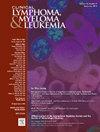Measurable Residual Disease Testing Following Nonintensive Chemoimmunotherapy is Predictive of Need for Maintenance Therapy in Previously Untreated Mantle Cell Lymphoma: A Wisconsin Oncology Network Study
IF 2.7
4区 医学
Q2 HEMATOLOGY
引用次数: 0
Abstract
Introduction
Obinutuzumab is hypothesized to improve progression-free survival (PFS) combined with bendamustine induction in mantle cell lymphoma (MCL). Measurable-residual disease (MRD) testing may predict benefit from maintenance therapy.
Methods
Adults (≥ 18 years) with untreated MCL ineligible for intensive therapies received 4 to 6 cycles of bendamustine + obinutuzumab (BO) followed by consolidation obinutuzumab (CO). Restaging after CO included MRD assessment by next-generation sequencing of bone marrow aspirate (BMA) and peripheral blood (PB). Maintenance obinutuzumab (MO) was omitted for patients with imaging complete response (CR) and MRD-negativity in PB/BMA. All other patients received 8 cycles MO. Primary endpoint is PFS; secondary endpoints are response rates, overall survival, and estimation of MRD status.
Results
Twenty-one patients enrolled, with median age 70 years and stage IV disease in 95%. Twenty patients completed BO; 10 patients received MO per protocol. Six patients did not complete MO due to progression (n = 4), infection (n = 1) and carcinoma (n = 1). Overall response is 95% (75% CR, 20% partial response). Concordance rate between post-consolidation MRD testing in PB and BMA was 70%.
After a median follow-up of 43.9 months, median PFS is 46.5 months. The observed difference between 2-year PFS in groups receiving MO versus observation was not statistically significant (HR 0.45, 95% CI, 0.10-1.91). Most common grade 3/4 toxicities were neutropenia, leukopenia, and infections.
Conclusions
BO is a tolerable induction regimen with higher rates of CR compared with historical rates with bendamustine + rituximab. Omission of MO did not worsen outcomes in patients achieving MRD-negative status after nonintensive induction/consolidation therapy.
非强化化学免疫疗法后的可测量残留疾病检测可预测曾接受过非强化化学免疫疗法治疗的套细胞淋巴瘤是否需要维持治疗:威斯康星肿瘤网络研究》。
简介假设奥比妥珠单抗与苯达莫司汀诱导治疗套细胞淋巴瘤(MCL)可改善无进展生存期(PFS)。可测量残留疾病(MRD)检测可预测维持治疗的获益情况:未经治疗且不符合强化治疗条件的成人(≥18岁)套细胞淋巴瘤患者接受4至6个周期的苯达莫司汀+奥比妥珠单抗(BO)治疗,然后接受奥比妥珠单抗巩固治疗(CO)。CO 后的重新分期包括通过骨髓抽吸物(BMA)和外周血(PB)的新一代测序进行 MRD 评估。对于影像学完全反应(CR)和PB/BMA中MRD阴性的患者,可省略奥比妥珠单抗维持治疗(MO)。所有其他患者均接受8个周期的MO治疗。主要终点是PFS;次要终点是反应率、总生存期和MRD状态估计:21名患者入组,中位年龄70岁,95%为IV期患者。20名患者完成了BO治疗;10名患者按方案接受了MO治疗。6名患者因病情进展(4人)、感染(1人)和癌变(1人)未完成MO。总体反应率为 95%(75% CR,20% 部分反应)。PB和BMA合并后MRD检测的一致性为70%。中位随访时间为 43.9 个月,中位 PFS 为 46.5 个月。观察发现,MO组与观察组的2年PFS差异无统计学意义(HR 0.45,95% CI,0.10-1.91)。最常见的3/4级毒性为中性粒细胞减少、白细胞减少和感染:BO是一种可耐受的诱导方案,其CR率高于苯达莫司汀+利妥昔单抗的历史比率。在经过非强化诱导/巩固治疗后达到MRD阴性状态的患者中,省略MO并不会恶化预后。
本文章由计算机程序翻译,如有差异,请以英文原文为准。
求助全文
约1分钟内获得全文
求助全文
来源期刊

Clinical Lymphoma, Myeloma & Leukemia
ONCOLOGY-HEMATOLOGY
CiteScore
2.70
自引率
3.70%
发文量
1606
审稿时长
26 days
期刊介绍:
Clinical Lymphoma, Myeloma & Leukemia is a peer-reviewed monthly journal that publishes original articles describing various aspects of clinical and translational research of lymphoma, myeloma and leukemia. Clinical Lymphoma, Myeloma & Leukemia is devoted to articles on detection, diagnosis, prevention, and treatment of lymphoma, myeloma, leukemia and related disorders including macroglobulinemia, amyloidosis, and plasma-cell dyscrasias. The main emphasis is on recent scientific developments in all areas related to lymphoma, myeloma and leukemia. Specific areas of interest include clinical research and mechanistic approaches; drug sensitivity and resistance; gene and antisense therapy; pathology, markers, and prognostic indicators; chemoprevention strategies; multimodality therapy; and integration of various approaches.
 求助内容:
求助内容: 应助结果提醒方式:
应助结果提醒方式:


